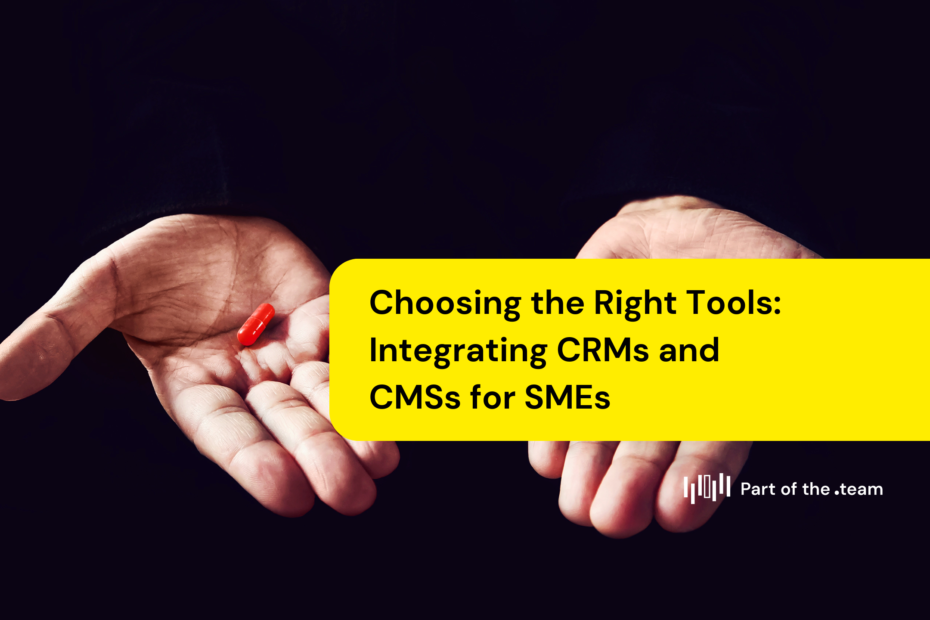Prioritisation conundrum
If you’re early into your startup journey, you’re likely weighing your options between implementing a robust Customer Relationship Management (CRM) system or a powerful Content Management System (CMS), which one should you prioritize first? If you’ve already made your decision and been working with it for a while you might be wondering if you’ve made the right decision?
The good and the bad news is that both tools are essential but serve different purposes.
Both CRMs and CMs are great examples of what Part of the .team likes to call Hero Packages.
Popular CRMs and CMSs: Different Tools for Different Needs

Before diving in, let’s take a look at some of the most popular CRM and CMS solutions available:
Popular CRMs:
– Salesforce – A leading CRM with robust features, though potentially expensive for smaller businesses.
– HubSpot CRM – Offers a free plan and powerful marketing/sales tools tailored for SMEs.
– Zoho CRM – User-friendly and affordable, designed specifically for small businesses.
– Microsoft Dynamics 365. – A comprehensive CRM platform that integrates well with Microsoft products.
– Monday.com – A versatile work management platform that can function as a CRM.
– Zendesk Sell: Focused on customer support and sales, with affordable pricing for small teams
– Adobe CRM (Marketing Cloud) – Primarily focused on marketing automation and analytics, suitable for larger SMEs with robust marketing needs.
Popular CMSs:
– WordPress. – A self-hosted, open-source CMS that’s highly customizable and widely used.
– Joomla. – Offers robust features and flexibility for building websites and applications.
– Drupal. – Known for its strong security and scalability, suitable for larger SMEs.
– Wix – A cloud-based website builder and CMS platform that’s user-friendly.
– Squarespace – Provides beautiful templates and an intuitive drag-and-drop interface.
– HubSpot CMS (Content Hub)1 – A proprietary CMS designed for businesses of any size, offering powerful features like personalization, A/B testing, and integration with HubSpot’s CRM and marketing tools.
As you can see, the lists for CRMs and CMSs are different because they serve distinct purposes. CRMs focus on managing customer relationships and sales processes, while CMSs are designed for content creation and website management. The tug between Marketing and Sales, sound familiar?
Prioritizing CRM Implementation
For most service-based SMEs, it’s generally advisable to start with a CRM system. Here’s why:
- Customer Acquisition is Crucial: In the early stages, acquiring and retaining customers is paramount. A CRM helps manage leads, contacts, and sales pipelines effectively, driving revenue and growth..[6]
- Sales and Marketing Alignment: CRMs facilitate alignment between sales and marketing teams, ensuring a cohesive customer experience.
- Data-Driven Decision Making: CRMs offer valuable insights into customer behavior, sales performance, and marketing effectiveness, guiding strategic decisions..[6]
- Scalability and Integration: Modern CRMs are designed to scale with your business and integrate with various other tools, providing a comprehensive ecosystem..
While a CMS is essential for managing and publishing website content, it is not as critical in the early stages compared to a CRM. Many startups initially use simple website builders like Wix before investing in a dedicated CMS as their content needs grow. That was the case for GW Functional Fitness as it’s a great shop window for your business.
Integration Issues Between CRM and CMS
Once your business is up and running, integrating your CRM and CMS can provide significant benefits, but it also comes with challenges:
- Data Synchronization: Ensuring customer information in the CRM is automatically shared with the CMS for personalized content delivery can be complex.
- Disjointed Marketing Efforts: Without integration, marketing campaigns created in the CRM may not seamlessly trigger personalized content delivery through the CMS based on customer behaviors.
- Siloed Customer View: Lack of integration can result in a fragmented view of the customer journey across the website (CMS) and sales/support interactions (CRM).
- Duplicated Efforts: Manually transferring data between systems can lead to inefficiencies and potential data inconsistencies.
- Limited Analytics: Analyzing the impact of website content on sales processes or using CRM data to optimize content performance becomes challenging.
At POTT, we have experience at overcoming these issues and integrating CRM and CMS platforms like Monday.com and Wix, respectively. Our case studies demonstrate how seamless integration can streamline operations and enhance customer engagement.
Ideal Integration and Workflow
Ok, so now that the problems you’re experiencing with your business isn’t uncommon, what should you be singing for? For optimal results, CRMs and CMSs should work together seamlessly:
- Customer Data Sync: Customer data from the CRM, such as contact information, purchase history, and preferences, should be seamlessly shared with the CMS.. This allows the CMS to personalize content based on customer profiles.
- Content Personalization: Using the customer data from the CRM, the CMS can dynamically generate and deliver personalized content experiences on websites, emails, and other channels.. This improves engagement and conversion rates.
- Lead Capture: The CMS can capture lead information from website forms or content downloads, which is then passed to the CRM for nurturing and sales follow-up.
- Campaign Management: Marketing campaigns created in the CRM can trigger the delivery of personalized content through the CMS based on customer behaviors and interactions.
- Analytics and Optimization: Data from the CMS on content performance and customer interactions can be fed back into the CRM for better segmentation, lead scoring, and campaign optimization..
By tightly integrating CRM and CMS platforms, you can create a seamless, data-driven approach to customer engagement, delivering relevant content at the right time in the customer journey.. This improves customer experiences, increases conversions, and fosters long-term loyalty.
Ready to take your business to the next level? Contact POTT today to learn more about how we can help you integrate your CRM and CMS for a more cohesive and efficient operation.

